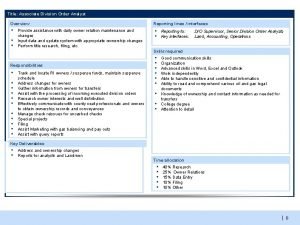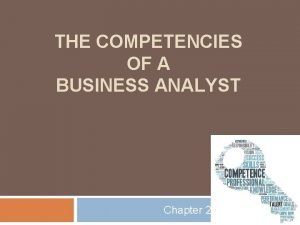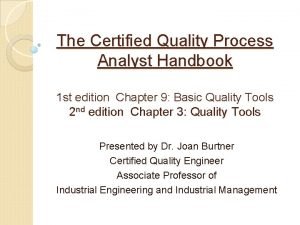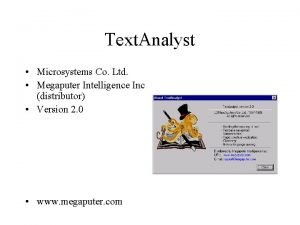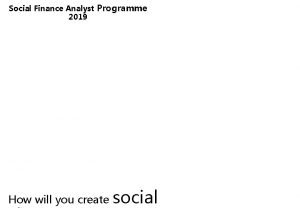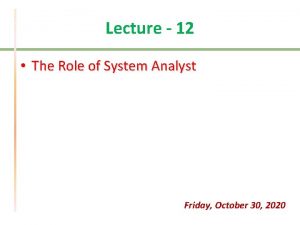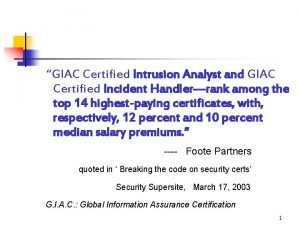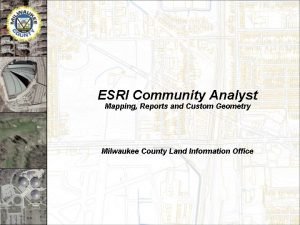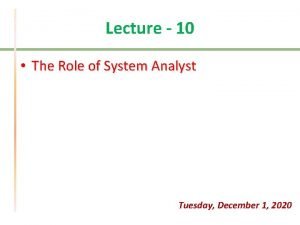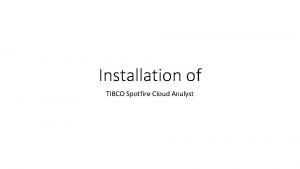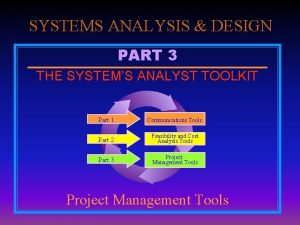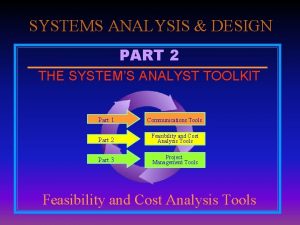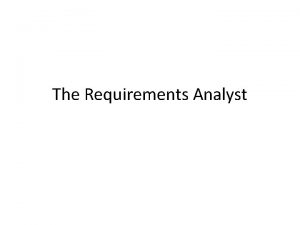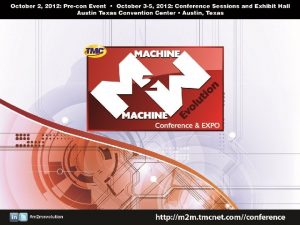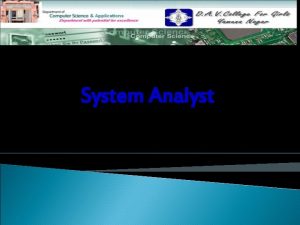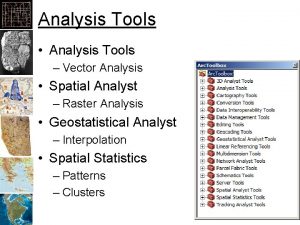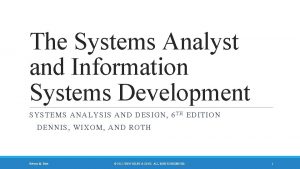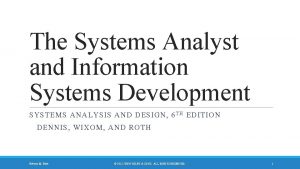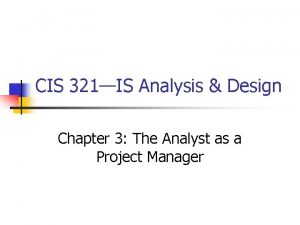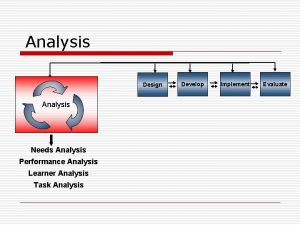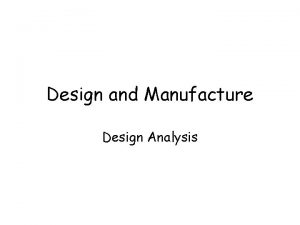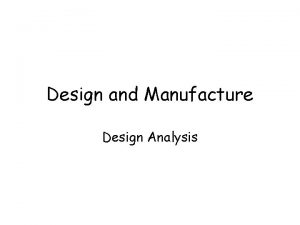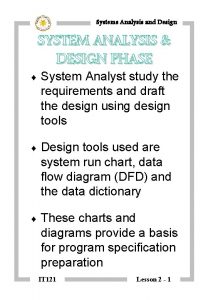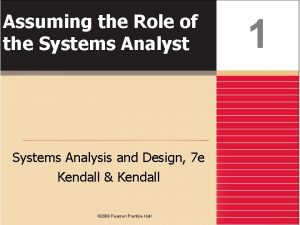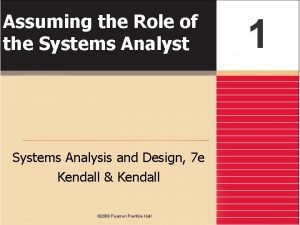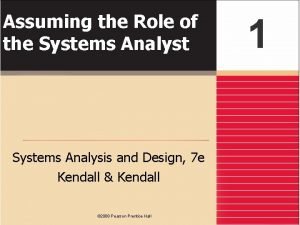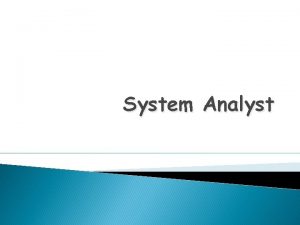SYSTEMS ANALYSIS DESIGN PART 1 THE SYSTEMS ANALYST

























- Slides: 25

SYSTEMS ANALYSIS & DESIGN PART 1 THE SYSTEM’S ANALYST TOOLKIT Part 1 Communications Tools Part 2 Feasibility and Cost Analysis Tools Part 3 Project Management Tools Communications Tools

TOOLKIT 1 The Systems Analyst’s Toolkit 2 Part 1 Communications Tools Part 2 Feasibility and Cost Analysis Tools Part 3 Project Management Tools Part 4 Alternative Systems Development Methodologies SYSTEMS ANALYSIS & DESIGN 4 E

TOOLKIT 1 The Systems Analyst’s Toolkit Part 1 Communications Tools SYSTEMS ANALYSIS & DESIGN 4 E 3

TOOLKIT 1 Objectives 4 à List the guidelines for successful communications à Explain the importance of effective letters, memos, and e-mail communication à Describe the organization of written reports that are required during the SDLC and explain each report section à List the guidelines for effective oral communication SYSTEMS ANALYSIS & DESIGN 4 E

TOOLKIT 1 Objectives à Organize and plan an oral presentation à Use speaking techniques to achieve your objectives SYSTEMS ANALYSIS & DESIGN 4 E 5

TOOLKIT 1 Introduction 6 à Successful systems analysts must have good written and oral communications skills à The Systems Analyst’s Toolkit provides guidelines for successful communications à Written communications à Oral communications SYSTEMS ANALYSIS & DESIGN 4 E

Guidelines for Successful Communications TOOLKIT 1 7 à The major objective is to make sure that your communication answers the questions why, who, what, when, and how SYSTEMS ANALYSIS & DESIGN 4 E

Guidelines for Successful Communications TOOLKIT 1 8 à Know why you are communicating and what you want to accomplish à Issues to consider à Is this communication necessary? à What am I trying to accomplish? à What specific results am I seeking? SYSTEMS ANALYSIS & DESIGN 4 E

Guidelines for Successful Communications TOOLKIT 1 9 à Know who your targets are à Issues to consider à What are the organizational and knowledge levels of the audience, and what are their information needs? à What is my overall communication strategy? à What feedback am I getting from the audience? SYSTEMS ANALYSIS & DESIGN 4 E

Guidelines for Successful Communications TOOLKIT 1 10 à Know what is expected of you, and when to go into detail à Issues to consider à This issue is related to the organizational and knowledge levels of the audience à Will the recipients expect you to address a specific issue or topic? à Will cost estimates or charts be expected? SYSTEMS ANALYSIS & DESIGN 4 E

Guidelines for Successful Communications TOOLKIT 1 11 à Know how to communicate effectively à Issues to consider à The Toolkit contains many helpful suggestions à Use your own experience à Observe the successful (and unsuccessful) experience of others SYSTEMS ANALYSIS & DESIGN 4 E

Guidelines for Successful Communications TOOLKIT 1 12 à Most importantly, know your subject à Consider what others will expect you to know and what questions they will ask à If you do not know the answer to a question, it is better to say “I don't know, but I’ll find out” rather than to guess SYSTEMS ANALYSIS & DESIGN 4 E

TOOLKIT 1 Written Communications 13 à Good writing is an essential skill à Written errors exist long after spoken words are forgotten à The major objective is to avoid grammatical, typographical, and spelling errors à There are many sources of information about developing good writing skills à Courses, especially business writing courses à Bookstores and libraries SYSTEMS ANALYSIS & DESIGN 4 E

TOOLKIT 1 Written Communications 14 à Suggestions for preparing written documents à Know your audience à Use active voice whenever possible à Keep your writing concise à Use one paragraph to convey a single idea à Use the right style à Use lists à Use short, easy-to-understand words à Check your work à Avoid repeating the same word too often à Check your spelling SYSTEMS ANALYSIS & DESIGN 4 E

TOOLKIT 1 15 Written Communications à Email, memos, letters à Most companies have standard formats à Templates give your work a consistent look à E-mail is less formal, but you still must follow the rules of good writing SYSTEMS ANALYSIS & DESIGN 4 E Click to see Figure 1 -1

TOOLKIT 1 Written Communications 16 à Reports à You prepare many reports during the SDLC à You can use a basic format and modify it as necessary à Cover letter à Introduction (title page, table of contents, brief description) à Summary à Findings à Recommendations (can include alternatives) à Appendix SYSTEMS ANALYSIS & DESIGN 4 E Click to see Figure 1 -2

TOOLKIT 1 Oral Communication 17 à An oral presentation might be necessary at any time during systems development à Oral presentations are especially important à At the end of the preliminary investigation à At the conclusion of the systems analysis phase SYSTEMS ANALYSIS & DESIGN 4 E

TOOLKIT 1 Oral Communication 18 à Define the audience à The presentation must meet the needs of the audience à Senior managers usually require less detail and a strategic overview SYSTEMS ANALYSIS & DESIGN 4 E

TOOLKIT 1 Oral Communication 19 à Define the objectives à Inform management of the status of the current system à Describe your findings concerning current system problems à Explain the alternative solutions that you developed à Provide detailed cost and time estimates à Recommend the best alternative and explain the reasons for your selection SYSTEMS ANALYSIS & DESIGN 4 E

TOOLKIT 1 Oral Communication 20 à Organize the presentation à Plan the presentation in three stages à Introduce yourself and describe your objectives à Make your presentation in a logical, clear manner à Deliver a conclusion that summarizes the main points and asks for questions SYSTEMS ANALYSIS & DESIGN 4 E

TOOLKIT 1 Oral Communication 21 à Define any technical terms à Avoid specialized or technical terminology whenever possible à Explain any terms that might be unfamiliar to the audience SYSTEMS ANALYSIS & DESIGN 4 E

TOOLKIT 1 22 Oral Communication à Prepare presentation aids à Visual aids can help the audience follow the logic of the presentation and hold their attention à Visual aids also can help you stay on track à Presentation graphics and slide shows are particularly effective techniques à First prepare the content, then focus on visual aids à Too many graphics, colors, or special effects will distract the audience SYSTEMS ANALYSIS & DESIGN 4 E Click to see Figure 1 -3

TOOLKIT 1 Oral Communication 23 à Practice is the most important part of your preparation à Rehearse several times à Be sure the presentation flows smoothly and the timing is correct à Do not write a script à Try to establish good rapport with the audience SYSTEMS ANALYSIS & DESIGN 4 E

TOOLKIT 1 Oral Communication 24 à The presentation à Sell yourself and your credibility à Control the presentation à Answer questions appropriately à Use good speaking techniques à Speak clearly and confidently à Control the pace of your delivery à Practice ways to control your nervousness SYSTEMS ANALYSIS & DESIGN 4 E

TOOLKIT 1 25 End Tookit Part 1 SYSTEMS ANALYSIS & DESIGN 4 E
 Systems analyst career progression
Systems analyst career progression Emsi analyst
Emsi analyst Division order analyst jobs
Division order analyst jobs Qa competency matrix
Qa competency matrix Certified quality process analyst
Certified quality process analyst Megaputer competitors
Megaputer competitors Subsurface analyst
Subsurface analyst Social finance analyst programme
Social finance analyst programme Shell lube analyst
Shell lube analyst Visible analyst
Visible analyst Explain the multifaceted role of system analyst
Explain the multifaceted role of system analyst What is an associate director
What is an associate director Giac intrusion analyst
Giac intrusion analyst Esri community analyst
Esri community analyst Talent analyst emsi
Talent analyst emsi Business analyst project case study
Business analyst project case study T shaped business analyst
T shaped business analyst Interpersonal skills of system analyst
Interpersonal skills of system analyst Tibco spotfire cloud
Tibco spotfire cloud Technical skills of system analyst
Technical skills of system analyst Cost analyst
Cost analyst System analyst as agent of change
System analyst as agent of change Cost analysis requirements description
Cost analysis requirements description Tony a data analyst for a major casino
Tony a data analyst for a major casino Business acceptance analyst
Business acceptance analyst Ifs business analyst
Ifs business analyst


